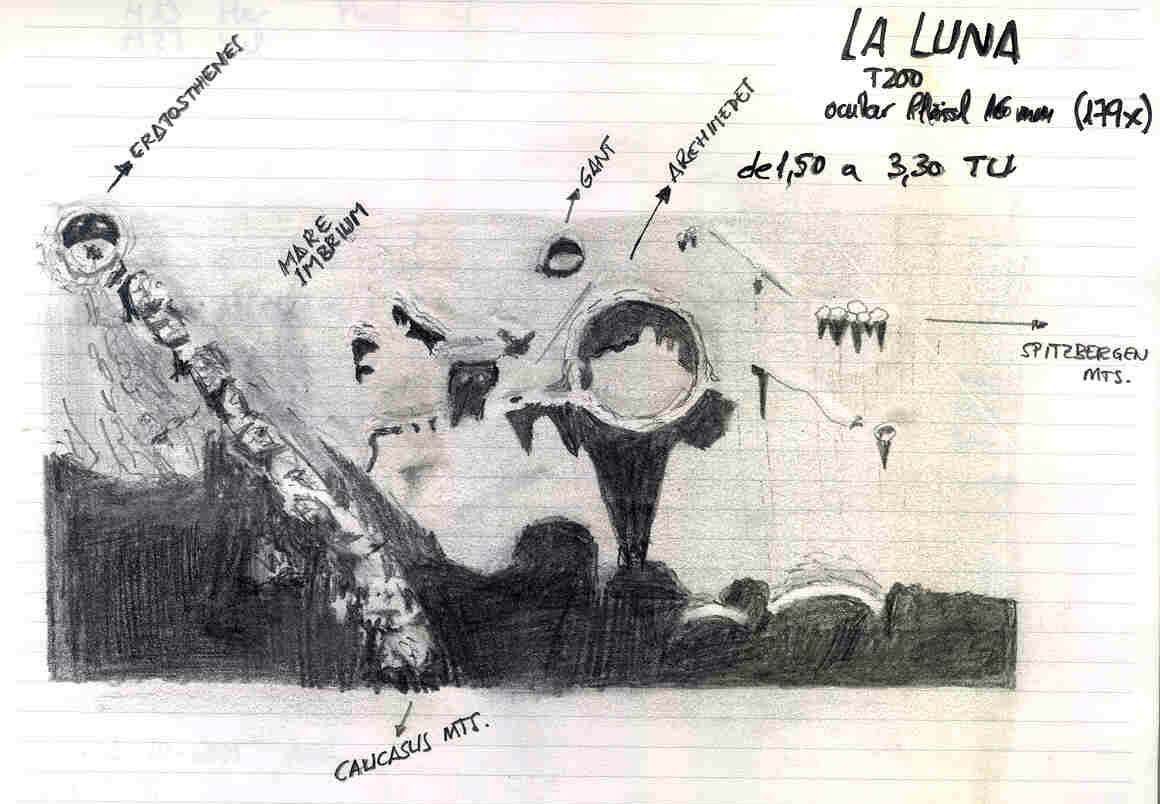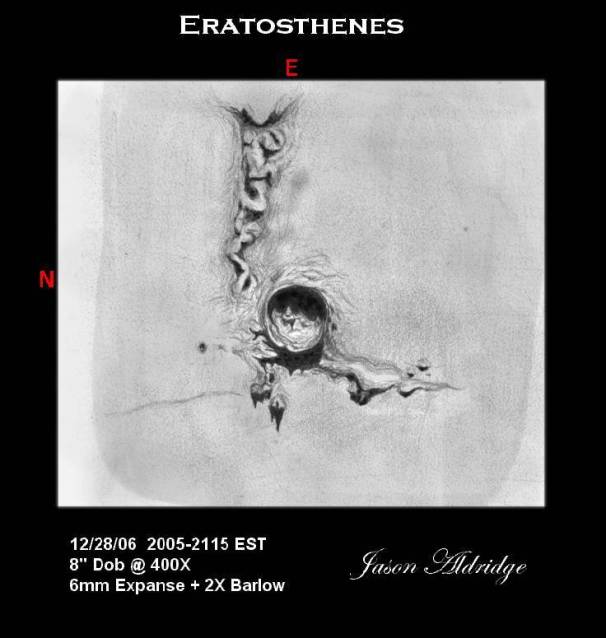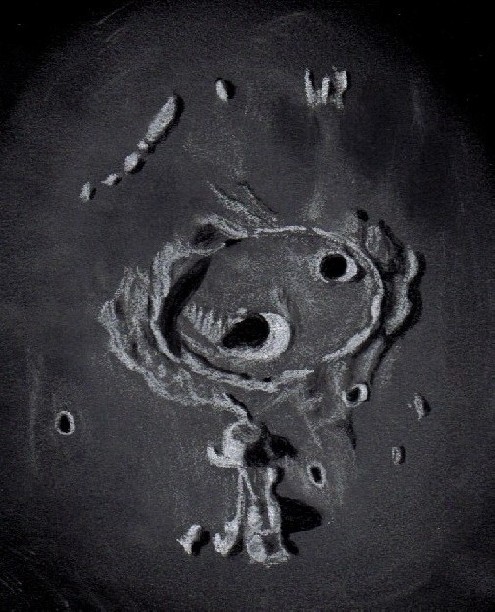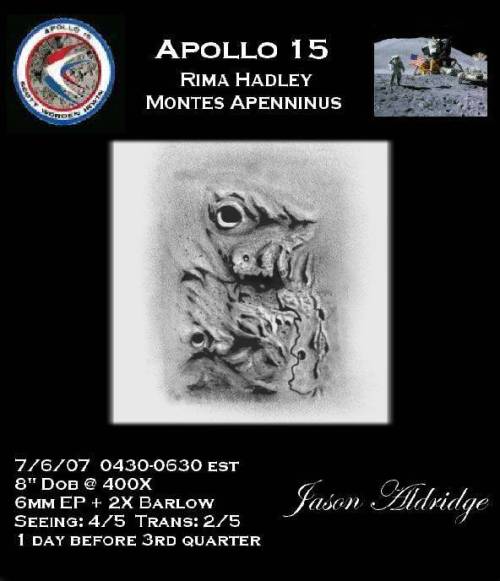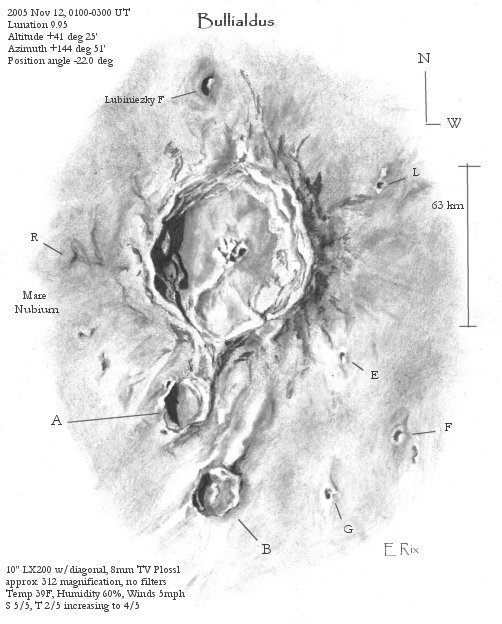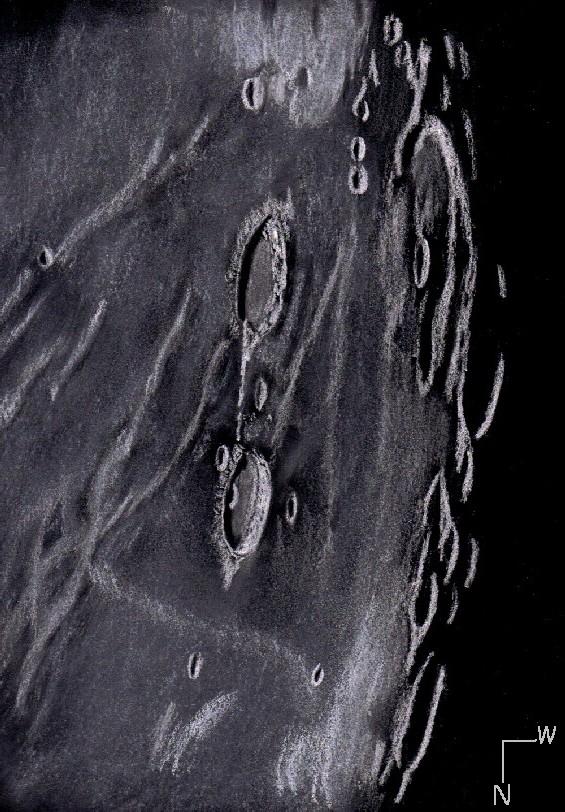THE MOON
Author: LUIS RIVAS from Valencia (Spain)
Date: 15 aug 1998
Newton telescope 8″ F:6
Plossl 16 mm eyepiece (179x)
drawing in 100 minutes
Category: Moon
First to measure the Earth
Crater Cassini
Day eight of a lunation is a favorite time to witness interesting light and shadow
play along the terminator from north to south. Crater Cassini is a very eye
catching crater and with a diameter of nearly 60km it is an attractive target for
telescopes of all sizes. At more than 3.5 billion years of age, Cassini is an old
battered nearly circular crater on the eastern edge of Mare Imbrium. The lava
basin around the crater appears mostly smooth and relatively dark. The ejecta
blanket immediately around this crater has an odd almost melted appearance. The
crater is shallow and the floor appears to be higher in elevation than the
surrounding mare; although this may be illusionary. Two large craters are visible
on Cassini’s floor. Crater A is the largest at 15 km.and the smaller B is about 9
km in diameter. Beyond the crater I sketched craters F, M and W all about 7 km in
size.
Between Crater A on the floor of Cassini and the nearest inner wall is a series of
rilles and hills that resemble fish bones. At other times I have seen a nice dome
to the lower left (northeast) of Cassini but with the crater too far from the
sunrise terminator I could not pick it out.
Sketching:
For this sketch I used: black Strathmore 400 Artagain paper, white and black Conte’
pastel pencils and a blending stump.
Telescope: 10 inch f/ 5.7 Dobsonian and 6 mm eyepiece 241X
Date: 3-27-2007 12:15-1:20 UT
Temperature: 20° C ( 69° F)
Partly cloudy, calm
Seeing: Antoniadi III
Colongitude 8.5 °
Lunation 8 days
Illumination 63.5 %
Frank McCabe
A Birthday Tribute
On August 5th 1971 the Astronauts of Apollo 15, David Scott, James Irwin, and
Alfred Worden were coming home. It was the 11th day of the mission, and the 2nd day
of their voyage back to Earth after a successful mission to the lunar surface.
Six days earlier on July 30th, Apollo 15 Commander David Scott and Lunar Module
(LM) pilot James Irwin had landed in the Rima Hadley/Montes Apenninus region of the
Moon in the Lunar Module Falcon. “OK, Houston. The Falcon is on the Plain at
Hadley.”, said David Scott upon touchdown. The Command and Service Module (CSM)
pilot, Alfred Worden continued in lunar orbit in the CSM Endeavour and conducted
scientific experiments. While on the lunar surface, Scott and Irwin made three
moonwalk Extra Vehicular Activities (EVAs), becoming the 7th and 8th men to walk on
the Moon. During the EVAs which totalled 18 hours, 35 minutes, they covered 27.9
km, and collected 76.8 kg of rock and soil samples. They also took photographs, set
up the Apollo Lunar Surface Experiments Package (ALSEP), and performed other
scientific experiments. This time the Astronauts didn’t just walk on the Moon, for
this was the first mission to employ the Lunar Roving Vehicle. Scott and Irwin used
the Rover to
explore regions within 5 km of the LM landing site. After the final EVA, David
Scott performed a televised demonstration of a hammer and feather falling at the
same rate in the lunar vacuum.
The LM lifted off from the Moon on August 2nd after 66 hours, 55 minutes on the
lunar surface. Once the Falcon docked with Endeavor, the lunar samples and other
equipment were transferred from the LM and it was jettisoned after a one orbit
delay.
The LM Falcon impacted the Moon on August 3rd, 93 km west of the Apollo 15 ALSEP
site. It had an estimated impact velocity of 1.7 km per second.
On August 4th, after Apollo 15 underwent an orbit-shaping maneuver, a scientific
subsatellite was spring-launched from the Scientific Instrument Module (SIM) bay
into lunar orbit. The Apollo 15 crew began the transearth injection on the next
orbit which started their long journey home.
The next day, August 5th, Alfred Worden stepped into the black vacuum 196,000 miles
from the earth to become the first man ever to take a floating excursion outside
his craft in interplanetary space. The Apollo 15 astronauts, in prearranged
collaboration with Soviet and Dutch astronomers, were trying to observe what some
scientists suspect are “black holes” in the sky.
Meanwhile, back on Earth, Niel Armstrong was celebrating his 41st birthday. In
Houston not too far from Mission Control, Credence Clearwater Revival was jamming
at the Coliseum . Across the Atlantic Ocean in Munich Germany, An American Soldier
and his wife (Justin and Janet Aldridge) were celebrating the birth of their first
child. They named him Jason.
Two days later on August 7th, the Apollo 15 Astronauts splashed down in the Pacific
Ocean, 330 miles north of Honolulu, Hawaii and 6.1 mi from the recovery ship USS
Okinawa. 16 months later, Apollo 17 Commander Eugene Cernan would be the last man
to walk on the Moon.
A child of Apollo, Jason would grow up with dreams of traveling to the Moon. He saw
the color photographs of Mars that returned from the Viking Missions, and he knew
that someday he would visit Mars as well. He watched as the Voyager spacecraft flew
past Jupiter, Saturn, Uranus, and Neptune, and he knew that Man would explore the
solar system and beyond in his lifetime.
Today I am 36 years old. The dreams I had as a child are all but a fond memory now.
No Human has been back to the Moon, and there have been no manned missions beyond
Earths orbit. NASA plans to return to the Moon by 2018, almost 50 years after Niel
Armstrong first set foot there. I think my feelings about this matter are best
described in the words of Apollo 15 Commander, David R Scott:
“As I stand out here in the wonders of the unknown at Hadley, I sort of realize
there’s a fundamental truth to our nature, Man must explore . . . and this is
exploration at its greatest.”
I would like to dedicate this lunar sketch to the brave men of Apollo 15, David R
Scott, James B Irwin, and Alfred M Worden. I am honored to have been born during
their historic mission.
Jason Aldridge
PS: Happy Birthday Niel Armstrong!
*Sources: NASA NSSDC Master Catalog Display: Spacecraft, Apollo Flight Journal, New
York Times articles from 8/6/1971, Credance Clearwater Revival official web site.
Sketching Materials: 0.5mm Mechanical Graphite Pencil, Strathmore Windpower Sketch
Paper, MGI Photosuite III software for post processing.
Big Fella and Bodacious Bullialdus
Poor transparency started the session and I was standing there next to the Big Fella
with disbelief showing across my face…no doubt the Big Fella’s face too, but the
dew shield was hiding his expressions from me. I took another swig of my tea and
said to heck with it, a few thin clouds aren’t going to get the best of me…not
after all that time setting up. So I pulled up my socks, changed the expression on
my face to determination and began my date with the Big Fella. Destination Moon.
I had already printed out VMA’s globe showing ideas for tonight’s session. But
peering the terminator and then working my way East, the Big Fella kept tugging me
to a triplet of craters just south of the border and a stone’s throw from the
terminator. It sure did look familiar, but I couldn’t put my finger on it.
Rays were streaking the surroundings like a burst of light just itching to break
free from the crust. And inside the main crater a peak so high and creviced that it
looked like a mini mountain reaching up to soak in the sunshine. If I walking in
that crater, I could easily have scaled the terraced walls, as well defined as they
were this night.
But wait…there wasn’t that much detail at first! I pulled free of the Big Fella
and looked up. The clouds were gone!
At this stage, I’ll end the actual tour to fill you in on what really excited me.
After I walked the Big Fella to his door (ok, so that door happens to be downstairs
from my door) I checked out on VMA what the mystery craters were. Of course…it
was Bullialdus and his two sisters A & B. Quickly flipping through my journal, I
came across this sketch I did with the Little Fella 6 months ago!
With that burning mystery put out, I was free to eat my supper, realizing that I had
forgotten all about the Enchiladas I cooked earlier. Big Fella was too cheap to
take me out for a meal…guess I can’t complain though, he gave me a grand tour on
the moon.
Erika Rix
Zanesville Ohio
Extra image from url:
Rite in Rain sketching paper, blending stump, stick of charcoal, charcoal stick in a
wooden holder.
Sketch Image courtesy Springer Science and Business Media, LLC from “Astronomical Sketching: A Step-by-Step Introduction” (2007)
A Catena Linked Pair
With high pressure moving into my observing area, there was a good chance that the
cloud cover would break up and move out before local midnight. Eventually it did.
The nearly full moon hung low and large in the sky to the south. The largest mare
on the lunar surface is the Ocean of Storms. A pair of similar looking, north to
south oriented craters at the western extreme of the Ocean of Storms is linked to
each other by a rille-like chain of craters. The southern most crater of the pair
is the 50 km. diameter Cardanus. This crater was demonstrating its terraced walls
and hilly irregular ramparts in the low altitude sunlight. Following the catena
southward for a little more than 60 km. we arrive at the other member of the pair
named Krafft. Like Cardanus crater Krafft (51 km.) has in addition to the features
of the former, a crater of 13 km off set from the center of the floor. The sun was
high enough to illuminate much of the impact debris of the region in the form of
numerous crater rays. Closer to both the terminator and limb of the moon in the
libration zone larger craters Vasco de Gama and Dalton are making their appearances
from the long lunar night.
Sketching:
For this sketch I used: black Strathmore 400 Artagain paper, white and black Conte’
pastel pencils and a blending stump. Contrast was slightly increased after scanning.
Telescope: 10 inch f/ 5.7 Dobsonian and 6 mm eyepiece 241X
Date: 7-29-2007, 3:10-4:30 UT
Temperature: 23° C (74° F)
Partly cloudy, calm
Seeing: Antoniadi III
Colongitude 83.6 °
Lunation 14.6 days
Illumination 99 %
Libration long. -4.7°
Frank McCabe
Beautiful Bullialdus
This is my impression of the Lunar Crater Bullialdus with it’s neighbors Konig and
Lubiniezky. It was sketched with a #2HB mechanical pencil on Strathmore Wind Power
Sketching Paper. Other pertinent details are on the sketch itself. I really enjoyed
drawing this sketch because of the detail I was able to see in Bullialdus (one the
smaller craters I’ve captured) and the surrounding landscape.
Jason Aldridge
Almost a Basin
As the 2007 year began, winter’s cold grip had not yet taken hold. I was finishing
the process of cleaning and repairing a 13 inch Newtonian telescope when I decided
to colliminate and test the optics on the star Polaris and the moon. The moon was
one day past full and upper Imbrian period crater Humboldt in the
east-south-eastern sector of the libration zone was nicely placed for sketching.
Crater Humboldt at 207 km. in diameter is classified as a large floor fractured
crater. If this crater was 33% larger it would be a lunar basin. On the Lunar 100
list crater Humboldt is number 87.
At or near full moon many observers avoid looking moonward but old Luna can be a
rewarding telescope target at any and every phase.
Sketching:
I used a No. 2 HB pencil on copy paper for this drawing
Date: 1-4-2007 4:00 to 4:40 UT
Temperature: 0°C (33° F)
Windy, some mid-altitude cloudiness, seeing was average
Antoniadi : III
13.1 inch f / 5.9 Dobsonian 9mm ortho ocular 218X
Colongitude: 91.9°
Lunation: 14.6 days
Illumination: 99.6 %
Libration in longitude. +5.5°
Frank McCabe
Center of the Lunar Nearside
When the moon is several degrees below the summer ecliptic to the south, it can be
challenging to view and sketch from mid-northern latitudes.
I chose for sketching a highland region inside the triad of the Bays of Medii and
Aestuum and the Sea of Vapors. The center of this region contains the crater pair
Pallas and Murchison. Crater Pallas (50km.) which is a Nectarian period formation
is more than 3.8 billion years old. Pallas has a partially buried central peak at
1.3 km. above the lava flooded floor. Crater Pallas-A rests on the western rim and
deep bowl shaped crater Bode beyond the rim are clearly seen. Murchison (58 km.)
which is the oldest of the pair at about 4 billion years shows the greatest amount
of wear. Lava flooded floor, severe wall erosion, and strikes such as Chladni
(13.8km.) on the southeastern wall are among the features that demonstrate the age
of this crater. All that remains of the common wall of Pallas-Murchison are pieces
of ridge wall. Half of well known crater Triesnecker is visible to the east.
I was unable to use higher magnification because sky conditions were below average
until after moonset.
Sketching:
For this sketch I used: black Strathmore 400 Artagain paper, white and black Conte’
pastel pencils and a blending stump. Contrast and brightness were slightly
increased after scanning.
Telescope: 10 inch f/ 5.7 Dobsonian and 9 mm eyepiece 161X
Date: 7-23-2007, 1:15-1:48 UT
Temperature: 24° C (75° F)
Partly cloudy, calm
Seeing: Antoniadi III
Colongitude 10.1 °
Lunation 8.6 days
Illumination 58 %
Frank McCabe
Lovely Limb
Crater Ingrahami
You have got to admit, on a clear winter night from the northern hemisphere the
full moon has a way of revealing itself and moving high and bright to the
meridian. After looking at the full moon through a telescope eyepiece you can be
quite moonblind for a while. Don’t make any sudden movements until your night
vision returns. This night was my rendezvous with the crater Inghirami. Crater
Inghirami is a Nectarian period crater (3.85 billion years old) and measuring 92
km.in diameter. This crater is southwest of Schickard and southeast of Vallis
Inghirami. The crater has an interesting floor with what looks like a low ridge
mountain range running across it. Inghirami crater is near the edge of the lunar
impact basin Mare Orientale. Below is my number 2 pencil and ink sketch on copy
paper of the region of Inghirami crater near both the terminator and limb.
Date: 1-3-2007 4:00 to 4:45 UT
Temperature: -2.2 °C (28° F)
Breezy, seeing was average
Antoniadi : III
13.1 inch f / 5.9 Dobsonian 6mm ortho ocular 327X
Colongitude: 83°
Lunation: 13.8 days
Illumination: 100 %
Frank McCabe

